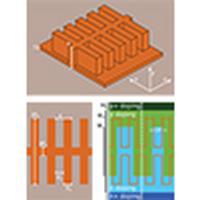当前位置:
X-MOL 学术
›
Photonics Res.
›
论文详情
Our official English website, www.x-mol.net, welcomes your
feedback! (Note: you will need to create a separate account there.)
Optimizing interleaved p-n junction to reduce energy dissipation in silicon slow-light modulators
Photonics Research ( IF 6.6 ) Pub Date : 2020-03-13 , DOI: 10.1364/prj.382620 Marco Passoni , Dario Gerace , Liam O’Faolain , Lucio Claudio Andreani
Photonics Research ( IF 6.6 ) Pub Date : 2020-03-13 , DOI: 10.1364/prj.382620 Marco Passoni , Dario Gerace , Liam O’Faolain , Lucio Claudio Andreani

|
Reducing power dissipation in electro-optic modulators is a key step for widespread application of silicon photonics to optical communication. In this work, we design Mach–Zehnder modulators in the silicon-on-insulator platform, which make use of slow light in a waveguide grating and of a reverse-biased p-n junction with interleaved contacts along the waveguide axis. After optimizing the junction parameters, we discuss the full simulation of the modulator in order to find a proper trade-off among various figures of merit, such as modulation efficiency, insertion loss, cutoff frequency, optical modulation amplitude, and dissipated energy per bit. Comparison with conventional structures (with lateral p-n junction and/or in rib waveguides without slow light) highlights the importance of combining slow light with the interleaved p-n junction, thanks to the increased overlap between the travelling optical wave and the depletion regions. As a surprising result, the modulator performance is improved over an optical bandwidth that is much wider than the slow-light bandwidth.
中文翻译:

优化交错 pn 结以减少硅慢光调制器中的能量耗散
降低电光调制器的功耗是将硅光子学广泛应用于光通信的关键步骤。在这项工作中,我们在绝缘体上硅平台中设计了 Mach-Zehnder 调制器,它利用波导光栅中的慢光和沿波导轴具有交错触点的反向偏置 pn 结。在优化结参数后,我们讨论了调制器的完整仿真,以便在各种品质因数(例如调制效率、插入损耗、截止频率、光调制幅度和每比特耗散能量)之间找到适当的权衡。与传统结构(具有横向 pn 结和/或在没有慢光的肋形波导中)的比较突出了将慢光与交错 pn 结相结合的重要性,由于行进光波和耗尽区之间的重叠增加。令人惊讶的结果是,调制器性能在比慢光带宽宽得多的光带宽上得到了改善。
更新日期:2020-03-13
中文翻译:

优化交错 pn 结以减少硅慢光调制器中的能量耗散
降低电光调制器的功耗是将硅光子学广泛应用于光通信的关键步骤。在这项工作中,我们在绝缘体上硅平台中设计了 Mach-Zehnder 调制器,它利用波导光栅中的慢光和沿波导轴具有交错触点的反向偏置 pn 结。在优化结参数后,我们讨论了调制器的完整仿真,以便在各种品质因数(例如调制效率、插入损耗、截止频率、光调制幅度和每比特耗散能量)之间找到适当的权衡。与传统结构(具有横向 pn 结和/或在没有慢光的肋形波导中)的比较突出了将慢光与交错 pn 结相结合的重要性,由于行进光波和耗尽区之间的重叠增加。令人惊讶的结果是,调制器性能在比慢光带宽宽得多的光带宽上得到了改善。











































 京公网安备 11010802027423号
京公网安备 11010802027423号